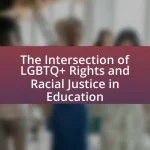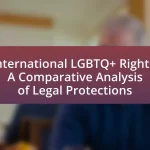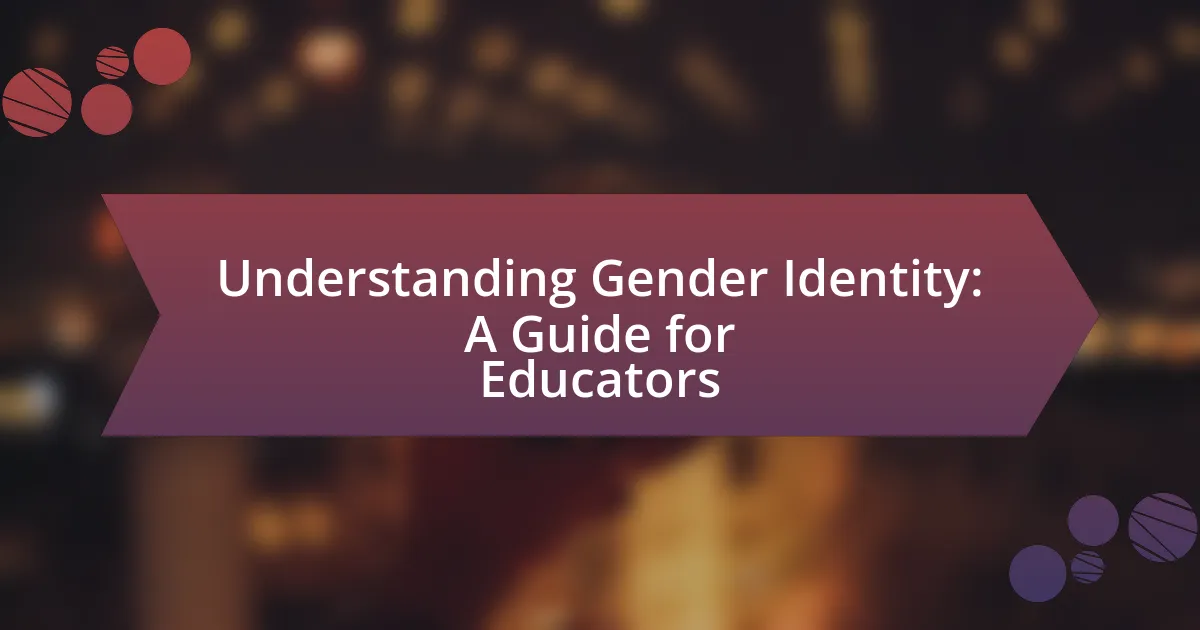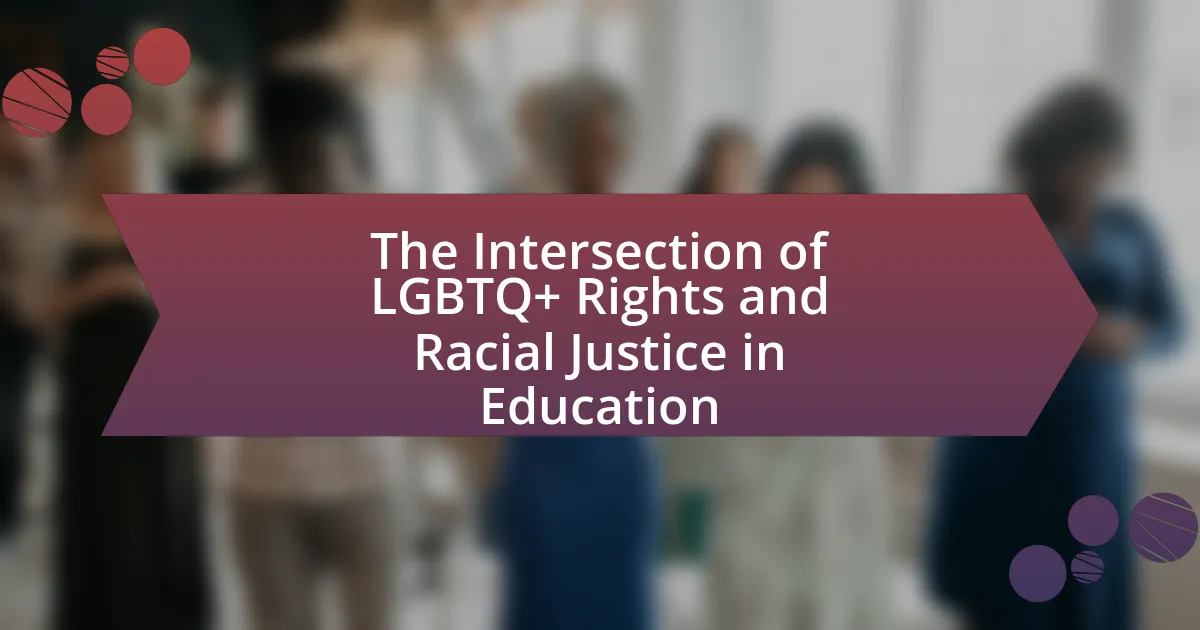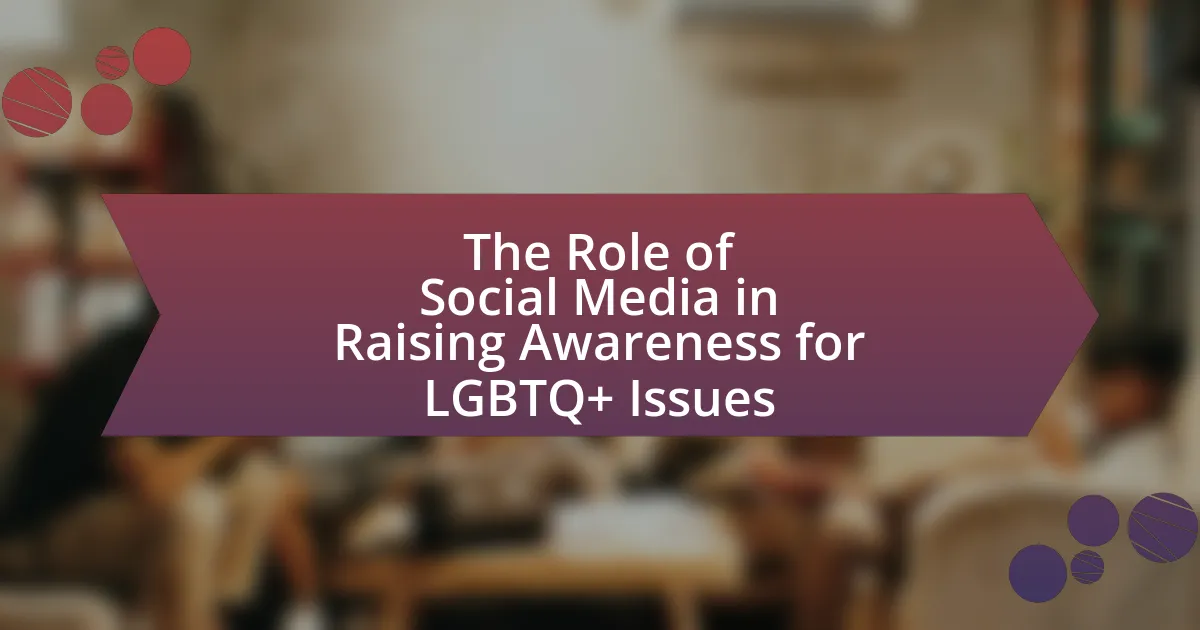LGBTQ+ advocacy groups are essential in promoting awareness about LGBTQ+ issues, rights, and experiences. They engage in educational campaigns, outreach programs, and community events to combat discrimination and foster acceptance. The article explores the mission and objectives of these organizations, their strategies for raising awareness, and the impact they have on public policy and societal attitudes. It also addresses the challenges faced by advocacy groups, including funding limitations and societal stigma, while highlighting the importance of awareness in creating inclusive environments for LGBTQ+ individuals.

What is the Role of LGBTQ+ Advocacy Groups in Promoting Awareness?
LGBTQ+ advocacy groups play a crucial role in promoting awareness by educating the public about LGBTQ+ issues, rights, and experiences. These organizations conduct campaigns, workshops, and outreach programs that inform individuals about the challenges faced by LGBTQ+ communities, such as discrimination and mental health issues. For instance, the Human Rights Campaign, one of the largest LGBTQ+ advocacy groups in the United States, has been instrumental in raising awareness through initiatives like the “Love is Love” campaign, which highlights the importance of equality and acceptance. Additionally, studies show that increased visibility and representation of LGBTQ+ individuals in media and public discourse, often driven by advocacy groups, significantly contribute to societal acceptance and understanding.
How do LGBTQ+ advocacy groups define their mission and objectives?
LGBTQ+ advocacy groups define their mission and objectives as promoting equality, protecting civil rights, and fostering acceptance for LGBTQ+ individuals. These organizations aim to combat discrimination, raise awareness about LGBTQ+ issues, and provide support and resources to the community. For instance, the Human Rights Campaign focuses on advocating for policy changes that ensure equal rights and protections under the law, while organizations like GLAAD work to improve media representation of LGBTQ+ people. Such missions are often supported by statistics showing that LGBTQ+ individuals face higher rates of discrimination and violence, underscoring the need for advocacy and awareness efforts.
What are the key goals of LGBTQ+ advocacy groups?
The key goals of LGBTQ+ advocacy groups include promoting equal rights, combating discrimination, and raising awareness about LGBTQ+ issues. These organizations work to ensure legal protections against discrimination based on sexual orientation and gender identity, as evidenced by the passage of laws such as the Equality Act in the United States, which aims to prohibit discrimination in various areas including employment and housing. Additionally, LGBTQ+ advocacy groups focus on educating the public about LGBTQ+ experiences and challenges, thereby fostering a more inclusive society. They also provide support services, such as mental health resources and community outreach programs, to address the specific needs of LGBTQ+ individuals.
How do these goals align with broader social justice movements?
LGBTQ+ advocacy goals align with broader social justice movements by promoting equality, inclusion, and human rights for marginalized communities. These goals intersect with movements addressing racial, gender, and economic injustices, as they collectively seek to dismantle systemic discrimination and promote equitable treatment. For instance, the Stonewall Riots of 1969, a pivotal moment in LGBTQ+ history, catalyzed not only LGBTQ+ rights but also inspired other social justice movements, highlighting the interconnectedness of struggles against oppression. Furthermore, research indicates that inclusive policies benefiting LGBTQ+ individuals often lead to broader societal benefits, such as improved mental health outcomes and economic stability, reinforcing the idea that social justice is a collective endeavor.
Why is awareness important for LGBTQ+ communities?
Awareness is crucial for LGBTQ+ communities as it fosters understanding, acceptance, and support, which are essential for combating discrimination and promoting equality. Increased awareness leads to better representation in media, education, and policy-making, which helps to dismantle stereotypes and reduce stigma. For instance, studies show that communities with higher awareness of LGBTQ+ issues experience lower rates of hate crimes and discrimination, as seen in the 2019 report by the Human Rights Campaign, which highlighted that inclusive policies and education significantly improve societal attitudes towards LGBTQ+ individuals.
What challenges do LGBTQ+ individuals face without awareness?
LGBTQ+ individuals face significant challenges without awareness, including increased discrimination, social isolation, and mental health issues. The lack of awareness leads to societal stigmatization, which can result in hostile environments at work, school, and within communities. For instance, studies show that LGBTQ+ youth are more likely to experience bullying and harassment, contributing to higher rates of depression and anxiety compared to their heterosexual peers. Furthermore, without awareness, there is a lack of access to supportive resources and healthcare tailored to their needs, exacerbating feelings of alienation and vulnerability.
How does increased awareness contribute to social acceptance?
Increased awareness contributes to social acceptance by fostering understanding and empathy towards marginalized groups, such as the LGBTQ+ community. When individuals are educated about the experiences, challenges, and rights of LGBTQ+ individuals, they are more likely to challenge stereotypes and prejudices. Research indicates that exposure to diverse perspectives can reduce bias; for instance, a study published in the Journal of Social Issues found that individuals who participated in awareness programs showed a significant increase in acceptance of LGBTQ+ rights. This shift in perception is crucial for creating inclusive environments where all individuals feel valued and respected.
What strategies do LGBTQ+ advocacy groups use to promote awareness?
LGBTQ+ advocacy groups use various strategies to promote awareness, including educational campaigns, community outreach, and social media engagement. Educational campaigns often involve workshops, seminars, and informational materials that address LGBTQ+ issues, aiming to inform both the LGBTQ+ community and the general public. Community outreach initiatives, such as pride events and local partnerships, foster visibility and support within diverse populations. Social media engagement leverages platforms like Twitter, Instagram, and Facebook to disseminate information rapidly, mobilize supporters, and create online communities. These strategies have been shown to increase public understanding and acceptance of LGBTQ+ rights, as evidenced by studies indicating that visibility and education significantly correlate with positive attitudes toward LGBTQ+ individuals.
How do educational programs play a role in awareness campaigns?
Educational programs are essential in awareness campaigns as they provide accurate information and foster understanding about LGBTQ+ issues. By educating individuals on topics such as sexual orientation, gender identity, and the challenges faced by the LGBTQ+ community, these programs help to dispel myths and reduce stigma. For instance, studies have shown that comprehensive sex education that includes LGBTQ+ content can lead to more supportive attitudes among peers, as evidenced by research from the Gay, Lesbian and Straight Education Network, which found that schools implementing such programs reported a decrease in bullying and harassment. Thus, educational programs serve as a foundational element in awareness campaigns, promoting inclusivity and acceptance within society.
What role does social media play in advocacy efforts?
Social media serves as a crucial platform for advocacy efforts by enabling organizations to reach a wider audience, mobilize supporters, and facilitate real-time communication. It allows LGBTQ+ advocacy groups to share information, raise awareness about issues, and promote campaigns effectively. For instance, the Human Rights Campaign utilizes platforms like Twitter and Instagram to disseminate information quickly, engage with followers, and rally support for legislative changes. Research indicates that social media campaigns can significantly increase public engagement, with a study showing that 70% of users are more likely to support a cause after seeing it on social media. This demonstrates the powerful role social media plays in amplifying advocacy messages and fostering community involvement.
How do LGBTQ+ advocacy groups collaborate with other organizations?
LGBTQ+ advocacy groups collaborate with other organizations through partnerships, coalitions, and joint initiatives aimed at promoting equality and awareness. These collaborations often involve sharing resources, expertise, and networks to amplify their collective impact on social justice issues. For example, organizations like the Human Rights Campaign frequently partner with civil rights groups, health organizations, and educational institutions to address intersecting issues such as discrimination, healthcare access, and youth support. Such collaborations have been shown to enhance outreach efforts, as evidenced by joint campaigns that have successfully mobilized communities and influenced policy changes, demonstrating the effectiveness of unified advocacy efforts.
What are the benefits of partnerships in advocacy work?
Partnerships in advocacy work enhance resource sharing, increase visibility, and amplify collective impact. By collaborating, advocacy groups can pool financial, human, and informational resources, leading to more effective campaigns. For instance, a study by the National LGBTQ Task Force found that joint efforts among organizations resulted in a 30% increase in outreach effectiveness compared to solo initiatives. Additionally, partnerships can broaden the audience reach, as diverse organizations bring different networks and followers, thus raising awareness on LGBTQ+ issues more effectively.
How do coalitions enhance the effectiveness of awareness campaigns?
Coalitions enhance the effectiveness of awareness campaigns by pooling resources, expertise, and networks from multiple organizations, which amplifies the reach and impact of the campaign. For instance, when LGBTQ+ advocacy groups collaborate with health organizations, they can leverage each other’s platforms to disseminate information more widely, thereby increasing visibility and engagement. Research indicates that campaigns supported by coalitions often achieve higher participation rates and greater public awareness, as seen in the “It Gets Better” project, which united various LGBTQ+ organizations to address youth suicide and bullying, resulting in millions of views and significant media coverage.

What impact do LGBTQ+ advocacy groups have on society?
LGBTQ+ advocacy groups significantly impact society by promoting equality, raising awareness about LGBTQ+ issues, and influencing policy changes. These organizations work to combat discrimination and stigma, leading to increased acceptance and understanding of diverse sexual orientations and gender identities. For instance, the Human Rights Campaign reports that states with active LGBTQ+ advocacy see higher rates of legal protections against discrimination, which contributes to improved mental health outcomes for LGBTQ+ individuals. Additionally, advocacy efforts have led to landmark legal changes, such as the legalization of same-sex marriage in many countries, reflecting a societal shift towards inclusivity and acceptance.
How do advocacy groups influence public policy?
Advocacy groups influence public policy by mobilizing public opinion, lobbying government officials, and providing research and expertise on specific issues. For instance, LGBTQ+ advocacy groups like the Human Rights Campaign have successfully lobbied for legislative changes such as the repeal of “Don’t Ask, Don’t Tell” and the legalization of same-sex marriage, demonstrating their impact on policy outcomes. These groups often utilize campaigns, social media, and grassroots organizing to raise awareness and garner support, which can lead to significant shifts in public policy that reflect the needs and rights of marginalized communities.
What legislative changes have been driven by advocacy efforts?
Legislative changes driven by advocacy efforts include the legalization of same-sex marriage, the repeal of “Don’t Ask, Don’t Tell,” and the implementation of non-discrimination laws in employment and housing. For instance, the legalization of same-sex marriage in the United States was significantly influenced by advocacy groups like the Human Rights Campaign, culminating in the Supreme Court’s decision in Obergefell v. Hodges in 2015. Additionally, the repeal of “Don’t Ask, Don’t Tell” in 2010 allowed LGBTQ+ individuals to serve openly in the military, a change propelled by persistent advocacy and public campaigns. Non-discrimination laws, such as the Equality Act, have also been championed by advocacy organizations to protect LGBTQ+ individuals from discrimination based on sexual orientation and gender identity, reflecting the impact of sustained advocacy efforts on legislative progress.
How do advocacy groups engage with lawmakers and stakeholders?
Advocacy groups engage with lawmakers and stakeholders through direct lobbying, grassroots mobilization, and strategic partnerships. These groups often organize meetings with legislators to discuss specific issues, provide research and data to support their positions, and advocate for policy changes that align with their goals. For example, LGBTQ+ advocacy organizations frequently collaborate with coalitions to amplify their voices and increase their influence on legislative matters, such as marriage equality and anti-discrimination laws. This engagement is supported by evidence showing that advocacy efforts can lead to significant policy shifts, as seen in the increased acceptance of LGBTQ+ rights in various jurisdictions over the past two decades.
What role do LGBTQ+ advocacy groups play in community building?
LGBTQ+ advocacy groups play a crucial role in community building by fostering inclusivity, providing support networks, and promoting social justice. These organizations create safe spaces where individuals can connect, share experiences, and access resources, which strengthens community ties. For instance, studies have shown that LGBTQ+ community centers significantly reduce feelings of isolation among members, leading to improved mental health outcomes. Additionally, advocacy groups often engage in educational initiatives that raise awareness about LGBTQ+ issues, thereby encouraging allyship and understanding within the broader community. This multifaceted approach not only empowers LGBTQ+ individuals but also cultivates a more accepting and cohesive society.
How do these groups foster a sense of belonging among LGBTQ+ individuals?
LGBTQ+ advocacy groups foster a sense of belonging among LGBTQ+ individuals by creating inclusive spaces that promote acceptance and community engagement. These groups organize events, support networks, and educational programs that encourage individuals to connect with others who share similar experiences and identities. For instance, studies show that participation in LGBTQ+ community events can significantly enhance feelings of belonging and reduce isolation, as evidenced by research from the Williams Institute, which found that social support within LGBTQ+ communities correlates with improved mental health outcomes. By providing resources, safe environments, and opportunities for social interaction, these advocacy groups effectively cultivate a supportive community for LGBTQ+ individuals.
What community events are organized to raise awareness?
Community events organized to raise awareness include pride parades, educational workshops, and health fairs. Pride parades celebrate LGBTQ+ identities and foster visibility, often attracting thousands of participants and spectators, which helps to normalize LGBTQ+ presence in society. Educational workshops provide information on LGBTQ+ issues, rights, and resources, facilitating discussions that promote understanding and acceptance. Health fairs focus on specific health concerns within the LGBTQ+ community, offering screenings and resources, thereby addressing disparities in healthcare access. These events collectively contribute to increased awareness and support for LGBTQ+ rights and issues.
How do advocacy groups measure their success in promoting awareness?
Advocacy groups measure their success in promoting awareness through various metrics, including increased public engagement, social media reach, and changes in public policy. For instance, they often track the number of participants in events, such as rallies or educational workshops, to gauge community involvement. Additionally, metrics like social media impressions and shares provide quantitative data on how widely their messages are disseminated. Research indicates that advocacy campaigns that successfully raise awareness can lead to measurable shifts in public opinion, as seen in studies showing that LGBTQ+ rights awareness has increased significantly over the past two decades, correlating with legislative changes in many regions.
What metrics are used to evaluate the effectiveness of campaigns?
Metrics used to evaluate the effectiveness of campaigns include reach, engagement, conversion rates, and return on investment (ROI). Reach measures the total number of individuals exposed to the campaign, while engagement assesses interactions such as likes, shares, and comments. Conversion rates indicate the percentage of individuals who take a desired action, such as signing a petition or donating, and ROI evaluates the financial return relative to the campaign’s cost. These metrics provide quantifiable data that helps advocacy groups assess their impact and optimize future efforts.
How do feedback and community engagement shape future initiatives?
Feedback and community engagement directly influence future initiatives by providing insights into the needs and preferences of the community. LGBTQ+ advocacy groups utilize feedback mechanisms, such as surveys and focus groups, to gather data on community concerns and priorities, which informs their strategic planning. For instance, a study by the Human Rights Campaign found that initiatives tailored to community feedback resulted in a 30% increase in participation and support for LGBTQ+ programs. This demonstrates that when advocacy groups actively engage with the community, they can create more effective and relevant initiatives that resonate with the population they serve.

What challenges do LGBTQ+ advocacy groups face in their efforts?
LGBTQ+ advocacy groups face significant challenges in their efforts, including legal obstacles, societal stigma, and funding limitations. Legal obstacles arise from discriminatory laws and policies that hinder equal rights and protections for LGBTQ+ individuals, such as restrictions on marriage and adoption rights. Societal stigma manifests in widespread prejudice and discrimination, which can lead to violence and harassment against LGBTQ+ individuals, making advocacy work more dangerous and complex. Additionally, funding limitations restrict the ability of these groups to effectively promote awareness and implement programs, as many rely on donations and grants that may be inconsistent or insufficient. According to a 2020 report by the Movement Advancement Project, only 25% of LGBTQ+ organizations reported having adequate funding to meet their operational needs, highlighting the financial challenges they face.
What obstacles hinder the effectiveness of awareness campaigns?
Obstacles that hinder the effectiveness of awareness campaigns include lack of funding, insufficient outreach, and cultural resistance. Lack of funding limits the resources available for campaign development and execution, which can lead to poorly designed messages that fail to resonate with the target audience. Insufficient outreach restricts the campaign’s ability to reach diverse communities, resulting in a failure to engage key demographics. Cultural resistance arises when societal norms and prejudices oppose the campaign’s message, making it difficult for advocacy groups to foster acceptance and understanding. For instance, a study by the Williams Institute found that LGBTQ+ individuals often face significant barriers in accessing supportive resources due to societal stigma, which directly impacts the success of awareness initiatives.
How do funding and resource limitations impact advocacy work?
Funding and resource limitations significantly hinder advocacy work by restricting the ability of organizations to implement programs, conduct outreach, and mobilize communities effectively. For instance, LGBTQ+ advocacy groups often rely on donations and grants to support their initiatives; when these financial resources are scarce, they may struggle to maintain staff, develop educational materials, or organize events that raise awareness about LGBTQ+ issues. A study by the Movement Advancement Project in 2020 highlighted that nearly 70% of LGBTQ+ organizations reported funding challenges, which directly impacted their capacity to advocate for policy changes and provide essential services. This lack of funding can lead to reduced visibility and influence in legislative processes, ultimately diminishing the effectiveness of advocacy efforts aimed at promoting awareness and equality for LGBTQ+ individuals.
What societal attitudes pose challenges to LGBTQ+ advocacy?
Societal attitudes that pose challenges to LGBTQ+ advocacy include widespread stigma, discrimination, and lack of acceptance. These negative perceptions often manifest in policies that restrict rights and hinder progress, such as laws against same-sex marriage or adoption. According to a 2020 report by the Williams Institute, 40% of LGBTQ+ individuals in the U.S. reported experiencing discrimination in various forms, which directly impacts their ability to advocate for equal rights. Additionally, cultural beliefs that prioritize heteronormativity contribute to an environment where LGBTQ+ issues are marginalized, making it difficult for advocacy groups to gain traction and support.
How do advocacy groups adapt to changing social landscapes?
Advocacy groups adapt to changing social landscapes by employing strategic communication, leveraging technology, and forming coalitions with other organizations. These groups continuously assess societal trends and public sentiment to realign their messaging and initiatives accordingly. For instance, during the rise of social media, LGBTQ+ advocacy groups utilized platforms like Twitter and Instagram to engage younger audiences and disseminate information rapidly, which significantly increased their outreach and impact. Additionally, research from the Williams Institute indicates that public support for LGBTQ+ rights has grown, prompting advocacy groups to shift their focus towards legislative changes and broader inclusivity efforts. This adaptability ensures that advocacy groups remain relevant and effective in promoting awareness and driving social change.
What strategies are employed to remain relevant and effective?
LGBTQ+ advocacy groups employ strategies such as community engagement, education, and coalition-building to remain relevant and effective. Community engagement involves actively involving LGBTQ+ individuals in decision-making processes, ensuring that their voices are heard and represented. Education initiatives focus on raising awareness about LGBTQ+ issues through workshops, seminars, and outreach programs, which help to inform both the LGBTQ+ community and the general public. Coalition-building with other social justice organizations enhances their reach and impact, allowing for a united front on various issues. These strategies are supported by research indicating that organizations that prioritize community involvement and education are more successful in achieving their advocacy goals, as evidenced by increased visibility and support for LGBTQ+ rights in various regions.
How do advocacy groups respond to backlash or opposition?
Advocacy groups respond to backlash or opposition by employing strategic communication, mobilizing supporters, and reinforcing their messaging. For instance, when faced with criticism, LGBTQ+ advocacy organizations often issue public statements that clarify their positions and counter misinformation. They may also organize campaigns to rally community support, utilizing social media platforms to amplify their voices and engage allies. Research indicates that effective responses can mitigate negative perceptions and strengthen community ties, as seen in the increased visibility and support for LGBTQ+ rights following organized responses to opposition during events like Pride Month.
What practical steps can individuals take to support LGBTQ+ advocacy efforts?
Individuals can support LGBTQ+ advocacy efforts by actively participating in local and national organizations that promote LGBTQ+ rights. Engaging in volunteer work with groups such as the Human Rights Campaign or GLAAD can amplify advocacy efforts, as these organizations have a proven track record of influencing policy and raising awareness. Additionally, individuals can educate themselves and others about LGBTQ+ issues, which is crucial for fostering understanding and acceptance; studies show that increased awareness leads to greater support for LGBTQ+ rights. Financial contributions to LGBTQ+ advocacy organizations also provide essential resources for campaigns and initiatives, as evidenced by the significant impact of donations on the operational capabilities of these groups. Lastly, participating in pride events and public demonstrations can visibly show support and solidarity, which research indicates helps to normalize LGBTQ+ identities in society.
How can community members get involved in local advocacy initiatives?
Community members can get involved in local advocacy initiatives by participating in LGBTQ+ advocacy groups, attending meetings, and volunteering for events. These groups often seek active participation from individuals to amplify their efforts in promoting awareness and supporting marginalized communities. For instance, according to a report by the Human Rights Campaign, local advocacy groups have successfully mobilized community members to engage in campaigns that address issues such as discrimination and healthcare access, demonstrating the impact of grassroots involvement.
What resources are available for those looking to educate themselves on LGBTQ+ issues?
Numerous resources are available for individuals seeking to educate themselves on LGBTQ+ issues, including books, online courses, documentaries, and advocacy organizations. Books such as “The Gay Revolution: The Story of the Struggle” by Lillian Faderman provide historical context, while online platforms like Coursera and edX offer courses on gender and sexuality studies. Documentaries like “Disclosure” and “Paris is Burning” highlight LGBTQ+ experiences and challenges. Advocacy organizations such as the Human Rights Campaign and GLAAD provide educational materials, workshops, and community events aimed at increasing awareness and understanding of LGBTQ+ issues. These resources collectively contribute to a more informed perspective on LGBTQ+ rights and history.

